Tucked just out sight and not too far from my Mile Cross home is a little corner of Norfolk that I have a real soft spot for: Hellesdon Station.
Back in the 1980’s I was shown a section of the remaining platform wall by my late mother as we took a walk from Norwich to Drayton one lovely summer’s afternoon and from that moment on I’ve been hooked on local history ever since. When I think about, It’s why I incessantly talk about local history with anyone willing to listen, It’s why I’ve created all of those Railway Ghost images, it’s why I pore over old maps and hunt for old photographs, and it’s why I love abandoned railway lines; particularly the M&GN. It’s all down to my mum and a collection of old bricks hiding in a set of bushes just off Hellesdon Road. I think it’s a form of therapy for me and the older I become the more I recognise it as a coping mechanism to deal with the premature death of my mother. Enough of that, back to some history…
Having officially been closed to passengers way back in 1952 Hellesdon Station is not well-remembered as one of Norwich’s former Railway Stations. The other Stations along this particular branch of the former M&GN line all managed to soldier on for another 7 years before it was all finally closed to passengers for good in 1959. The yard (and line) remained open for another 10 years for freight services and the station building was put to alternative uses.
After closure to passengers, you can see lovely view it would have had back then: Looking back along the platform towards Norwich:
Looking back along the platform towards Norwich: Why did this particular station close so much earlier than the rest? Well that was mainly due to its location in what is now known as ‘Old’ Hellesdon. It wasn’t far enough out from City Station to deflect passengers its way and wasn’t close to well, anything really. Back when it was built in 1882 the area was pretty sparse; there was Lower Farm just around the corner (now the Marlpit Arms), a small collection of houses near to the River Mill and not much else, apart from a large Asylum about a mile away. It seems that this former Asylum, now Hellesdon Hospital is partly the reason the railway company thought it prudent to build a ‘large’ Station here. It was expected that Hellesdon would grow into a large suburb of Norwich and whoever checked the local census failed to realise that the surrounding population figures were given a rather healthy boost by the patients residing at Hellesdon Hospital. The idea that Hellesdon as a suburb would grow turned out to be a sound one, but what wasn’t anticipated was that it would expand in the opposite direction, away from the Station and out towards Cromer Road. It turns out that even had Hellesdon expanded the other way – as the planners had hoped – it still wouldn’t have helped to save this beautiful old Railway Station anyway, as the better-late-than-never expansion coincided with the demise of most of the railways snaking their way across the Norfolk Countryside.
Why did this particular station close so much earlier than the rest? Well that was mainly due to its location in what is now known as ‘Old’ Hellesdon. It wasn’t far enough out from City Station to deflect passengers its way and wasn’t close to well, anything really. Back when it was built in 1882 the area was pretty sparse; there was Lower Farm just around the corner (now the Marlpit Arms), a small collection of houses near to the River Mill and not much else, apart from a large Asylum about a mile away. It seems that this former Asylum, now Hellesdon Hospital is partly the reason the railway company thought it prudent to build a ‘large’ Station here. It was expected that Hellesdon would grow into a large suburb of Norwich and whoever checked the local census failed to realise that the surrounding population figures were given a rather healthy boost by the patients residing at Hellesdon Hospital. The idea that Hellesdon as a suburb would grow turned out to be a sound one, but what wasn’t anticipated was that it would expand in the opposite direction, away from the Station and out towards Cromer Road. It turns out that even had Hellesdon expanded the other way – as the planners had hoped – it still wouldn’t have helped to save this beautiful old Railway Station anyway, as the better-late-than-never expansion coincided with the demise of most of the railways snaking their way across the Norfolk Countryside.
I often wonder if a Station located at the back of Sloughbottom Park serving Mile Cross would have seen more custom and I think ‘Mile Cross Station’ would have had a nice ring to it. I would though, wouldn’t I?
Closed for good: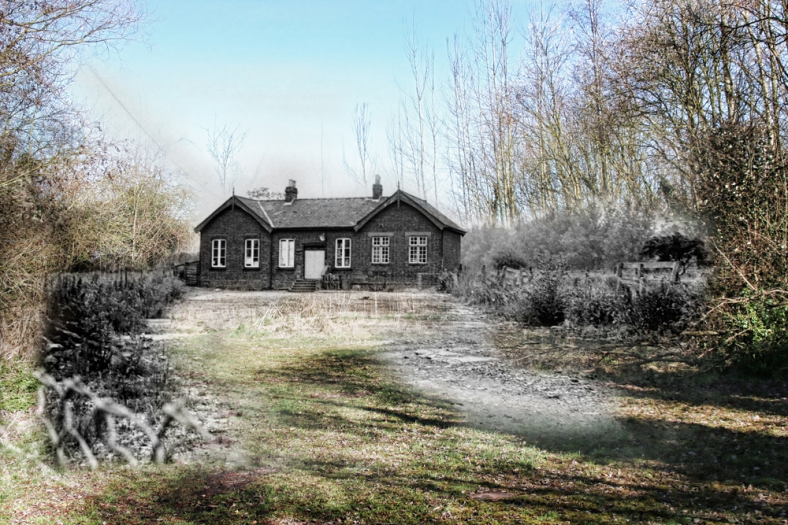
Although Hellesdon stopped serving passengers back in 1952, the station building lived on and was put to use for a number of purposes before it was finally demolished in 1975. It was used as a Sunday School and a youth club for a while and then by a local Catering Company (Anglian Culinary Services). I heard from a local that In its final days it was being used as a drinking den for the local youths and this was probably a major factor when the Council took the decision to demolish it for good. The rails here continued to see freight traffic right up until the track was lifted in the early 70’s. This particular stretch – and all the way in to City Station Yard at Heigham Street – was still in use as a rather long siding for Drayton Station up until 1969, and beyond. I’d like to think that the children attending the Sunday School would have immediately dropped their tasks and rushed over to the platform windows to watch one of those Diesel freight trains rumbling slowly by, no doubt much to the annoyance of their teacher. As well as the regular freight movements, the yard at Hellesdon was still being used by the Council to store road aggregates so it would have still seen quite a lot of rail activity in its final days.
The Station itself was built by contractors Wilkinson & Jarvis for the Lynn and Fakenham Railway as they made there way from Melton Constable to Norwich City and because it was (incorrectly) assumed that this part of Hellesdon was to become a major suburb a Large Pavillion-style building was opted for and it first opened its doors to the general public on the 2nd December, 1882. If you’ve ever been to Whitwell and Reepham to see the resurgence of steam on the Marriott’s Way you’ll have seen what Hellesdon Station would have looked like had it still been standing. Accessed via the large car park off Hellesdon Road you would have entered into the building through the main double doors and into the large central waiting room (which had 2 fires to keep you warm in the colder months) and a collection of rooms off of each side. There would have been a ticket office, a porters room, a gents toilet (accessed from outside) and a larger bathroom for the Victorian ladies which could be accessed directly from inside the station. No going outside in the cold for the ladies! You would have purchased your tickets through a ticket hatch that opened directly into the ticket office. Passengers could then either keep warm by one of the fires or go outside and taken a seat on the platform. From here you would be able see across the bottom of the Wensum Valley, across the Station’s large cattle fields (lairage) and admire the tall structure of Hellesdon Mill or the fantastic-looking old bridge carrying the roadway over the Wensum. You might have even admired the neatly arranged station garden on the other side of the single track or taken in the aromas of the neatly trimmed rose bush (that is still there today) that grew between the Station’s large name-board and behind the bench. A bit further down the platform would have stood a small signal box used to control entry into the sidings on the opposite of the Station yard, but it was taken out of action in around 1900 and used instead for storage. The archway for the signal box can still be seen today through a hole in the platform, although the platform wall had to be bricked up when all the rodding was removed and you can still make out the newer brickwork if you look closely. The replacement ground-frame hut was located a little further down the line and we recently found the foundations for it in amongst the undergrowth.
The riverbridge and the entrance to the yard just out of shot on the right:
Although the station was never all that busy with passengers it did see healthy amounts of freight, particularly with cattle from Ireland that would have been let out to graze on the extensive lairage fields stretching from the back of the Cattle run and all the way down to the river near to Hellesdon Mill before being sent to the Cattle Market.
The last train to pass through Hellesdon would have been this track-lifting and demo train being pulled by a diesel shunter and luckily for us Mrs Wright was there to capture it all on film. The following images were taken from the bridge as the crew made there way through the now-overgrown and neglected station, lifting the track as they went.
Looking towards Sloughbottom from the road bridge: Station and platform: (note the Anglian Culinary Supplies van in the car park):
Station and platform: (note the Anglian Culinary Supplies van in the car park): The track being lifted outside the station building:
The track being lifted outside the station building: Not only did this demo crew lift the track, they were also tasked wish pushing over or dismantling any of the remaining track furniture they could find and this was done to ensure that nobody else could easily relay track here in the future. An act nothing short of vandalism on BR’s behalf. Signal posts were snapped at their foundations, telegraph poles were chain-sawed and toppled, The beautiful concrete ¼ Mile posts were mostly smashed up or pushed over, the remaining M&GN metal signage was removed, Metal bridge number plates were removed or toppled into nearby dykes, and all of the vintage lamps were removed. They didn’t take everything however, they missed a few bits hidden in the undergrowth and quite a few of the metal items had already been plundered by collectors of Railwayana. Some of these items are now worth a lot of money to collectors and would be put to great use by some of the Heritage Railways such as the North Norfolk Railway or Whitwell and Reepham Station.
Not only did this demo crew lift the track, they were also tasked wish pushing over or dismantling any of the remaining track furniture they could find and this was done to ensure that nobody else could easily relay track here in the future. An act nothing short of vandalism on BR’s behalf. Signal posts were snapped at their foundations, telegraph poles were chain-sawed and toppled, The beautiful concrete ¼ Mile posts were mostly smashed up or pushed over, the remaining M&GN metal signage was removed, Metal bridge number plates were removed or toppled into nearby dykes, and all of the vintage lamps were removed. They didn’t take everything however, they missed a few bits hidden in the undergrowth and quite a few of the metal items had already been plundered by collectors of Railwayana. Some of these items are now worth a lot of money to collectors and would be put to great use by some of the Heritage Railways such as the North Norfolk Railway or Whitwell and Reepham Station.
Demolition of the Station from the bridge: For whatever reasons it was then decided by the council that Hellesdon Station was to be demolished and in 1975 and the diggers moved in to tear the building down. At around the same time the accompanying railway bridge carrying Hellesdon Road over the track was to be demolished and the road realigned to make getting cars over the weak and narrow Wensum bridge and around the s-bend a bit easier. I can imagine that had the bridge not been removed this road would be particularly hard to navigate with the volumes of traffic that pass through there today; two narrow bridges with a blind turn in the middle would lead to some very angry drivers, especially with the mentality of some of today’s road users. It’s a shame they couldn’t have kept the bridge and bypassed it somehow like they have elsewhere in the county but I’m guessing that – like today – money was a factor here. The pretty bridge was unceremoniously demolished using explosives and its rubble was then used to reform the bank to straighten the road. If you take a look in the bank leading back down to the footpath you can still see remnants of some of the bridge’s blue engineering bricks poking out of the soil:
For whatever reasons it was then decided by the council that Hellesdon Station was to be demolished and in 1975 and the diggers moved in to tear the building down. At around the same time the accompanying railway bridge carrying Hellesdon Road over the track was to be demolished and the road realigned to make getting cars over the weak and narrow Wensum bridge and around the s-bend a bit easier. I can imagine that had the bridge not been removed this road would be particularly hard to navigate with the volumes of traffic that pass through there today; two narrow bridges with a blind turn in the middle would lead to some very angry drivers, especially with the mentality of some of today’s road users. It’s a shame they couldn’t have kept the bridge and bypassed it somehow like they have elsewhere in the county but I’m guessing that – like today – money was a factor here. The pretty bridge was unceremoniously demolished using explosives and its rubble was then used to reform the bank to straighten the road. If you take a look in the bank leading back down to the footpath you can still see remnants of some of the bridge’s blue engineering bricks poking out of the soil: Looking at some of these photographs given to me over the last few years of the demolition in progress I think that the original plan was to preserve the bridge at the cost of the Station building by diverting the road down into the station yard, around the bridge and back out through the original car park and entrance. The demolition pictures look as though a lot of soil had been moved where I think the road was supposed to go and it strikes me as rather odd that there are newly-planted trees next to a bridge that would soon be demolished with explosives. Perhaps this plan came into some unknown snags and there was a change of plan. If anybody could shed any light on it, I’d love to know.
Looking at some of these photographs given to me over the last few years of the demolition in progress I think that the original plan was to preserve the bridge at the cost of the Station building by diverting the road down into the station yard, around the bridge and back out through the original car park and entrance. The demolition pictures look as though a lot of soil had been moved where I think the road was supposed to go and it strikes me as rather odd that there are newly-planted trees next to a bridge that would soon be demolished with explosives. Perhaps this plan came into some unknown snags and there was a change of plan. If anybody could shed any light on it, I’d love to know.
Below is an image of the bridge being completely isolated River to the right):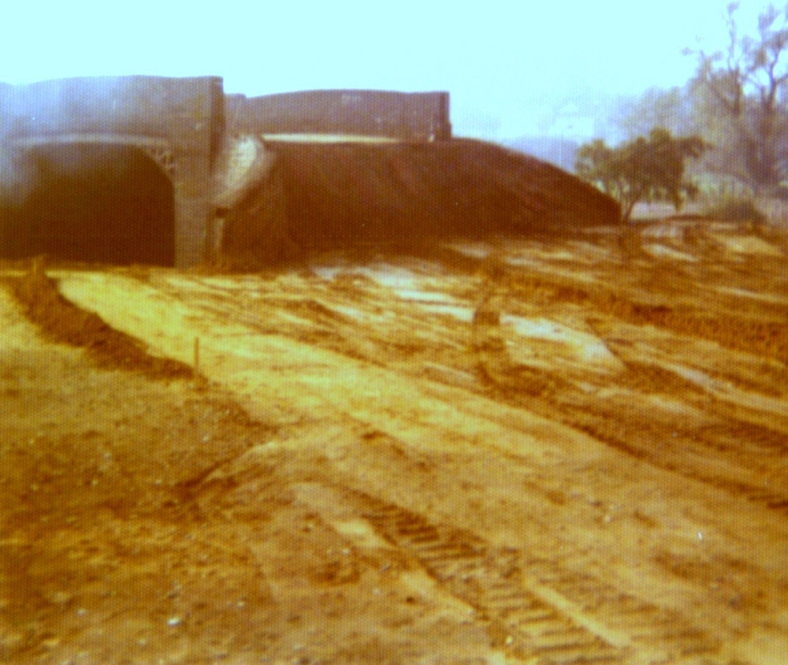 As you can see from the images, the Station building was thoroughly demolished along with about a third of its platform before the seeming change of heart. The remaining section of platform was neatly finished off in red brick and everything that wasn’t of any real value or was too big to destroy (or steal) was left behind. Most of it still there in amongst the bushes.
As you can see from the images, the Station building was thoroughly demolished along with about a third of its platform before the seeming change of heart. The remaining section of platform was neatly finished off in red brick and everything that wasn’t of any real value or was too big to destroy (or steal) was left behind. Most of it still there in amongst the bushes.
Platform re-finished in red brick: And yesterday after a recent clearance work:
And yesterday after a recent clearance work: There’s an entire cattle platform with metal cattle runs, the entrance driveway leading to the car park still attached to Hellesdon Road, the long goods ramp and it’s large metal gate leading up to the main gates by the river bridge, fence posts made out of rail and sleepers, the massive posts that held the Station name board, concrete fence-posts and lamp-holders made at Melton Constable in the 1920’s with William Marriott’s patented reinforced concrete, an occupational farm crossing gate, an archway for the signal box and up until recently the M&GN concrete Mile Post (pushed over by the demo crew) used for letting the drivers know how far they were from South Lynn (more on that later). On top of all that the station-master’s prised Rose Bush is still growing on top of the platform, although it hasn’t been trimmed for at least 66 years!
There’s an entire cattle platform with metal cattle runs, the entrance driveway leading to the car park still attached to Hellesdon Road, the long goods ramp and it’s large metal gate leading up to the main gates by the river bridge, fence posts made out of rail and sleepers, the massive posts that held the Station name board, concrete fence-posts and lamp-holders made at Melton Constable in the 1920’s with William Marriott’s patented reinforced concrete, an occupational farm crossing gate, an archway for the signal box and up until recently the M&GN concrete Mile Post (pushed over by the demo crew) used for letting the drivers know how far they were from South Lynn (more on that later). On top of all that the station-master’s prised Rose Bush is still growing on top of the platform, although it hasn’t been trimmed for at least 66 years!
Cattle run: Cattle platform, still covered in whitewash:
Cattle platform, still covered in whitewash: Granite sets with whitewash on top of cattle platform:
Granite sets with whitewash on top of cattle platform: Newer platform wall after removal of signal box:
Newer platform wall after removal of signal box: Melton (MRC) concrete stamp on a gate post leading to the cattle lairage fields:
Melton (MRC) concrete stamp on a gate post leading to the cattle lairage fields: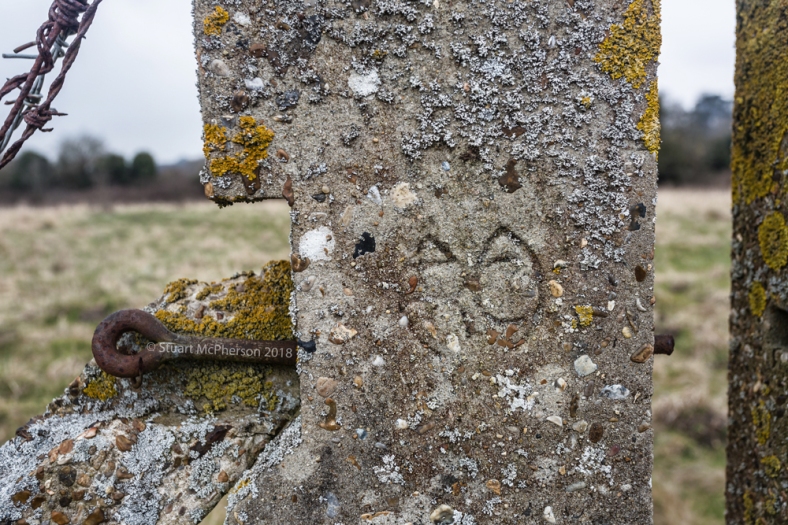 Telegraph remains:
Telegraph remains: Station Master’s Rosebush, still going strong:
Station Master’s Rosebush, still going strong: Station nameboard posts with the out-of-control rosebush still growing in between them:
Station nameboard posts with the out-of-control rosebush still growing in between them: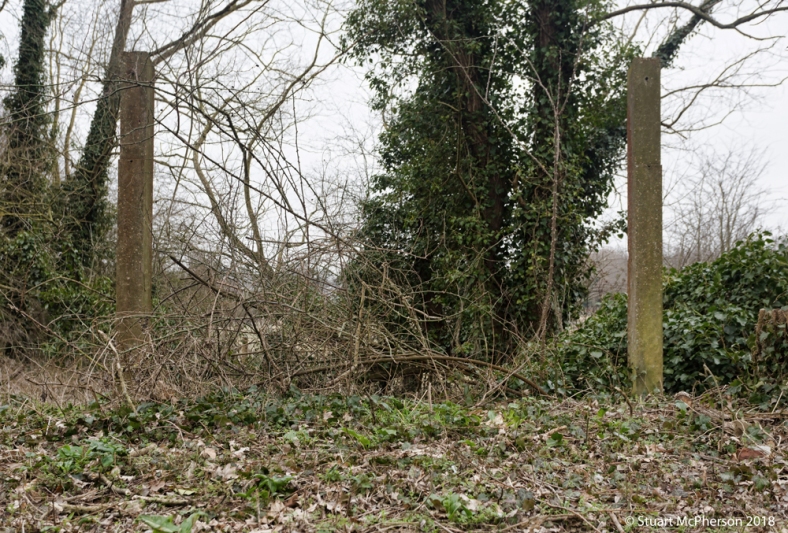
It’s a real shame that the original station building was demolished as it was one of only a handful of this design in Norfolk, making it quite unique as well as being an attractive example of Victorian architecture. I think it would have made for a rather nice dwelling or a much-needed community centre, however, we can’t change that now. What we can do is to promote what is still there and draw peoples attention to it, and that is exactly what I’ve been trying to do for almost a decade. 8 years ago now and after seeing some pictures of the Hellesdon Station Name board posts posted online by my now good friend John Batley, I decided to go and re-visit the remains of Hellesdon with my camera and to see what else I could find. I ended up getting a little bit carried away with myself and removed all of the ivy from the remaining platform. It was hard work but well worth it and it was great to see the Victorian Brickwork exposed once more. What I didn’t realise at the time was that it was to be these simple actions that would help to plant a little seed in the Local Railway Heritage scene that has grown and grown ever since. Not too long after that spontaneous bit of ivy clearance the Friends of Norwich City Station (FONCS) [link to FONCS post] were formed and out of that grew the Norfolk Railway Heritage Group (NRHG), Friends of Train Wood and Marriott’s Way and the recent successful Marriott’s Way Heritage Lottery Fund Bid.
Our success with helping to secure the Heritage Lottery Fund Bid for Marriott’s Way has also spurred on a similar Norfolk County Council bid to expose the Railway Heritage along the Weavers Way (which I’m also involved with) which appears to be gathering increasing momentum as I type. What have we started here?! I have to remind myself every now and again that a group of strangers (myself, John Batley, Dan Knights and Nick Stone) taking a little bit of interest in their surroundings and talking to each over the internet started all of this.
Whilst FONCS were doing a bit of research at Hellesdon Station a few years back we managed to find the knocked-over and half-buried M&GN concrete Mile Post that stood proud opposite the former signal box. These beautifully-made pre-cast concrete items were made in the early 1920’s as a replacement for the original wooden items that were probably becoming tired and rotten. There would have been one of these every quarter of a mile and they were used to allow the engine drivers to know their exact location and to work out their speed. It was a lucky find as most of these have either been destroyed or stolen so we decided to rescue it. When removed from the ground these concrete posts stand at 5 foot tall and weigh 15 stone, quite a hefty item. It shows the damage caused when the demo crew used heavy equipment but luckily it remained in one piece. We managed to get it into a friends van and back to mine so we could give it a good clean and photograph and measure it before deciding the next best course of action for it.
Recovered milepost being measured before restoration: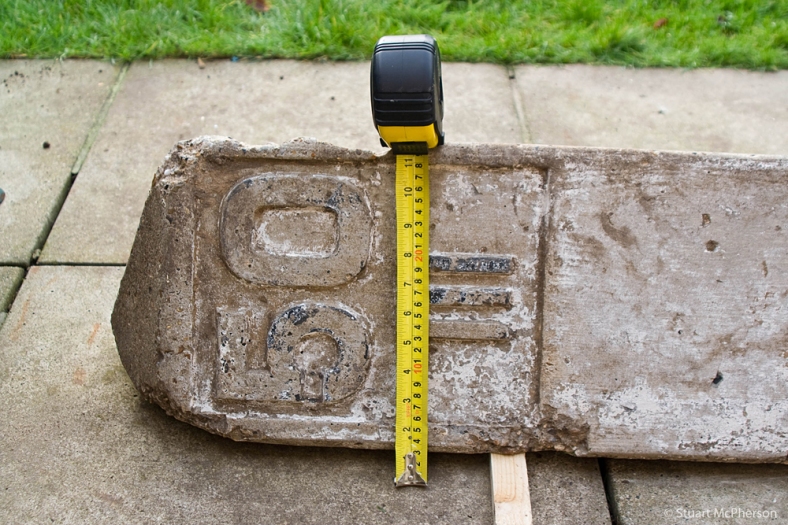 Since restoring it as best as I could it’s been living down the end of my garden, slowly being hidden by an increasingly-large privet hedge that I planted behind it a few years back and I’ve never really been happy with it being down here and out of sight, after all it doesn’t really belong to me. It belongs to the County. Norfolk County Council bought the trackbed and all its bridges (now Marriott’s Way) for the princely sum of £1 after British Rail ceased to be a thing. It’s always been in the back of my head that this thing should go back into the ground in its upright position by the side of the track where it belongs. There are only about 5 of these mileposts surviving along the Marriott’s Way, presumably missed by the demo crews and it would nice to add another one back to that collection.
Since restoring it as best as I could it’s been living down the end of my garden, slowly being hidden by an increasingly-large privet hedge that I planted behind it a few years back and I’ve never really been happy with it being down here and out of sight, after all it doesn’t really belong to me. It belongs to the County. Norfolk County Council bought the trackbed and all its bridges (now Marriott’s Way) for the princely sum of £1 after British Rail ceased to be a thing. It’s always been in the back of my head that this thing should go back into the ground in its upright position by the side of the track where it belongs. There are only about 5 of these mileposts surviving along the Marriott’s Way, presumably missed by the demo crews and it would nice to add another one back to that collection.
Restored milepost with signs of damage casued by the demo crew. The number denotes the distance from South Lynn in miles: And its Melton Concrete Works creation date stamp of 16th October, 1923:
And its Melton Concrete Works creation date stamp of 16th October, 1923:
Luckily, our successfull Marriott’s Way Heritage Lottery Fund bid has freed up some cash to spend on improving the site of the old Railway Station here at Hellesdon and our work should begin this year, so I thought that this would be the perfect opportunity to reunite this unique lump of old Railway History with its original home as part of the site’s revamp. Obviously, we’ll have to cement it in good and proper to prevent it from going walk-abouts, but it will be put back in the ground far more securely than its remaining siblings. I’ll make sure of that.
As well as putting the Mile Post back in the ground where it belongs we aim to reinstall a copy of the Hellesdon Station name-board using the original posts, add some surfacing to the remains of the platform to stop it becoming overgrown again and so that people can walk along it, repoint the original 1882 brickwork to help it last a few more decades, put up some signage so that people passing through can identify what they are looking at and maybe reinstate the bench on the platform. Hopefully I’ll then get the chance to finally give the former Station-master’s prize-winning rose bush the long-overdue prune that it deserves.
An interesting little story I read to come out of Hellesdon Station is that of a Cambridge-based Carrot grower that had decided it would be financially wise to install a carrot-washing plant using the nearby Wensum to help clean their carrots. These carrots would then be loaded onto wagons to be sent off down the rails and sold all across Europe. This would have brought the station up to 15,000 tonnes of freight per annum, a healthy and much-needed boost to the M&GN coffers; however, this little enterprise was to be very short-lived. Within a week the City’s Waterworks (less than a mile downstream) had noticed serious contamination to the City’s water supply and the threat of some very serious legal action put an end to this particular money-spinner before it had a chance to get off the ground.
The trains and their stations may have long since disappeared from this part of the City but their spirit will live on for a few years more, thanks to our hard work and passion. I’m sure my mum would as be proud as punch to think that her showing me these old platform remains all those years ago would have created a spark inside my young mind that would go on and lead to all the work and effort to preserve and promote this fantastic and hidden historical gem for the future generations.
This is for you, mum x
Hellesdon now and then (looking back towards Mile Cross under Hellesdon Road):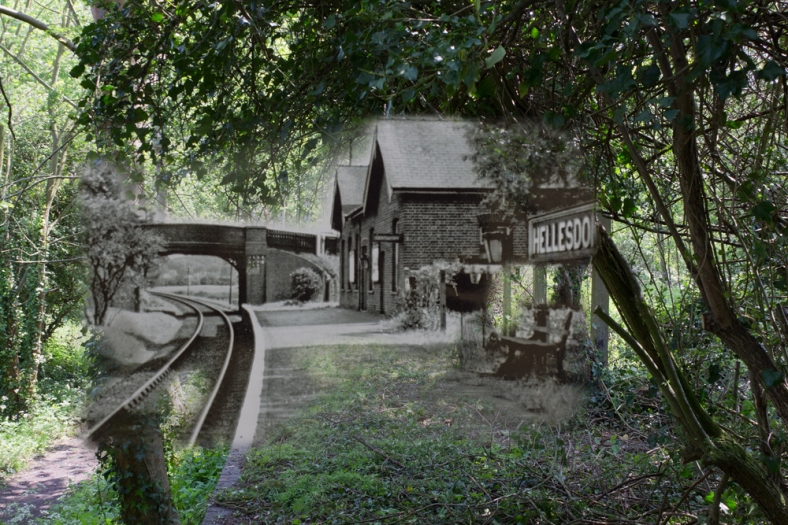 Hellesdon Road, looking towards Marlpit just after the bridge was demolished and road realigned:
Hellesdon Road, looking towards Marlpit just after the bridge was demolished and road realigned:
I’ll be doing a follow-up to this blog once our work at Hellesdon is complete so watch this space.
Thanks once again for reading,
Stu
That’s terrific Stu – a great read.
I lived at Riverside Close in the 1960s and we used to play around the old station in the summer. I remember freight trains passing along the line in the early ‘70s; often in the early hours for some reason.
Later, in the late ‘70s/early ‘80s, I rode along the old trackbed on a scrambler, dodging the holes on the metal bridge that spanned the river just east of Drayton Station as the wooden slats on the bridge had been allowed to fall into disrepair. Feats of real derring-do for a 16 year old!
LikeLike
Thanks for the article. In Norwich visiting family this W/E. Going to Hellesdon today. When I lived in N Earlham we use to cycle down to here, remember the station well. Was once standing on the bridge in the 70s and a diesel loco came through. Your piece helps me put a date on that.
LikeLiked by 1 person
Another great piece of local history Stu
LikeLiked by 1 person
I live in the area and found this article very interesting. I often take walks with my partner along Marriott’s Way and have often wondered what it was like in the day of the railways! Many thanks.
LikeLiked by 1 person
Awesome. Loving your work Stu, always an interesting and informative read.
LikeLiked by 1 person
A lovely piece of local history enhanced by your blog, congratulations. I live locally and often walk to the station to view the remains. The stumps af many of the telegraph poles and a gradient post are still visible along this end of Marriotts Way.
Best Wishes, Grum
LikeLiked by 1 person
I thoroughly enjoyed reading this piece, so evocative.
I only found the station tonight, although I spotted some information about the open day last month ana that was the first time I became aware of its existence – and I only live 10 minutes walk away from it!
The hard work has been very well worth it. Thank you for saving this for everyone to enjoy. I’m going to head back another time and take a look for some of the features you have pointed out.
LikeLiked by 1 person
Thanks, glad you enjoyed reading it. Stu.
LikeLike
Very interesting, remember the station from my early childhood, living in Lower Hellesdon.
LikeLiked by 1 person
I’ve lived in nearby Hellesdon Close ,for the last 31 years , and never knew about this . Fascinating ! I’ll deff. have to explore.. I wonder if I would’ve seen any of the station across from my flat .?Janet.
LikeLiked by 1 person
Hi Janet, it would have all been far more open back then and the Mill was clearly visible from the platforms when the Station was open.
LikeLike
Many, many thanks for this; anything relating to the old lines and stations of Norfolk I find a total fetish.
Mad Mick – ex BR; Anglia Railways; annual summer commuter from Nottm to Yarmouth Beach and lover of all things M&GN
LikeLiked by 1 person
Hi Mick, have you read parts two and three? You might also enjoy my M&GN ghost images.
LikeLike
What I found on the Lowestoft to gorlston Norfolk and Suffolk railway near plesuerwood hills and then restored to its former glory most of you old boys would die for a mile post!!!!!!! 2 1/2 miles from coke ovens junction
Y
LikeLiked by 1 person
I have lived in the area all my life I can remember the bridge being demolished, all us kids where disappointed when it wasn’t blown up but taken down bit by bit. I remember playing on the tracks before removal and especially the high level footbridge over the railway at the Dolphin. I now have a fascination for the M&GN, especially for the Norwich branch. Down with the Great Eastern!
LikeLiked by 1 person
Fantastic insight to local history. Thank you
LikeLiked by 1 person
Huh, well that explains the road.
I’d always presumed there had been a level crossing there rather than a bridge.
LikeLiked by 1 person